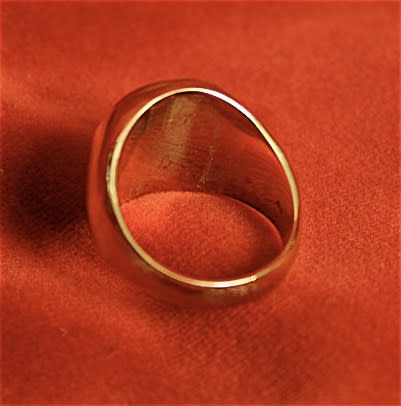Gold Ring Featuring a Roman Carnelian Intaglio Depicting a Bust of the God Serapis, 100 CE - 300 CE
Carnelian and Gold
FJ.6672
Further images
This Ancient Seal Has Been Set in a Modern 18 Karat Gold Rin The art of glyptics, or carving images on colored precious stones, is probably one of the oldest...
This Ancient Seal Has Been Set in a Modern 18 Karat Gold Rin
The art of glyptics, or carving images on colored precious stones, is probably one of the oldest known to humanity. Intaglios, gems with an incised design, were made as early as the fourth and third millennia B.C. in Mesopotamia and the Aegean Islands. They exhibit a virtuosity of execution that suggests an old and stable tradition rooted in the earliest centuries. The tools required for carving gems were simple: a wheel with a belt-drive and a set of drills. Abrasives were necessary since the minerals used were too hard for a metal edge. A special difficulty of engraving intaglios, aside from their miniature size, was that the master had to work with a mirror-image in mind.
The god Serapis is the personified form of the Apis bull, the sacred cow of Egypt. He was honored under the attributes of Osiris and was lord of the underworld. Such a deity represents the cultural exchange and adaptation between Ancient Rome and Roman Egypt.
This stunning ring represents a merger between two cultures and two eras. The god Serapis is a Romanized form of the sacred Egyptian Apis bull. Thus, the Romans adapted and reinvented this sacred creature in a humanized form more similar to their own gods. Furthermore, this stunning ring is itself a link between two worlds. This ancient seal is no relic preserved behind a glass case; but a glorious ring set in modern gold. When placed on our fingers, the glories of old are rekindled and the past comes alive again in the present.
The art of glyptics, or carving images on colored precious stones, is probably one of the oldest known to humanity. Intaglios, gems with an incised design, were made as early as the fourth and third millennia B.C. in Mesopotamia and the Aegean Islands. They exhibit a virtuosity of execution that suggests an old and stable tradition rooted in the earliest centuries. The tools required for carving gems were simple: a wheel with a belt-drive and a set of drills. Abrasives were necessary since the minerals used were too hard for a metal edge. A special difficulty of engraving intaglios, aside from their miniature size, was that the master had to work with a mirror-image in mind.
The god Serapis is the personified form of the Apis bull, the sacred cow of Egypt. He was honored under the attributes of Osiris and was lord of the underworld. Such a deity represents the cultural exchange and adaptation between Ancient Rome and Roman Egypt.
This stunning ring represents a merger between two cultures and two eras. The god Serapis is a Romanized form of the sacred Egyptian Apis bull. Thus, the Romans adapted and reinvented this sacred creature in a humanized form more similar to their own gods. Furthermore, this stunning ring is itself a link between two worlds. This ancient seal is no relic preserved behind a glass case; but a glorious ring set in modern gold. When placed on our fingers, the glories of old are rekindled and the past comes alive again in the present.





